CFD Investigation into Flow Characteristics of a Special Splash Lubrication in Light Helicopters
Abstract
:1. Introduction
2. Methodology
2.1. Governing Equations
2.2. Multiphase Flow Model
2.3. Turbulence Model
2.4. Numerical Method
2.5. Numerical Model and Grids
3. Experimental Validation
3.1. Test Rig
3.2. Experimental Test
4. Results
5. Conclusions
Author Contributions
Funding
Institutional Review Board Statement
Informed Consent Statement
Data Availability Statement
Acknowledgments
Conflicts of Interest
References
- Haudgins, W.A.; Schuetz, H.A. Loss-of-Lubrication of Helicopter Transmissions. J. Am. Helicopter Soc. 1982, 27, 3–10. [Google Scholar] [CrossRef]
- Ouyang, B.; Ma, F.; Dai, Y.; Zhang, Y. Numerical analysis on heat-flow-coupled temperature field for orthogonal face gears with oil–jet lubrication. Eng. Appl. Comput. Fluid Mech. 2021, 15, 762–780. [Google Scholar] [CrossRef]
- Peng, Q.; Gui, L.; Fan, Z. Numerical and experimental investigation of splashing oil flow in a hypoid gearbox. Eng. Appl. Comput. Fluid Mech. 2018, 12, 324–333. [Google Scholar] [CrossRef]
- Wu, W.; Wei, C.; Yuan, S. Numerical simulation of ball bearing flow field using the moving particle semi-implicit method. Eng. Appl. Comput. Fluid Mech. 2022, 16, 215–228. [Google Scholar] [CrossRef]
- Moshammer, T.; Mayr, F.; Kargl, K.; Honeger, C. Simulation of oil flow in gear box housing. In Proceedings of the SAE 2006 World Congress & Exhibition, Detroit, MI, USA, 3–6 April 2006. [Google Scholar] [CrossRef]
- Li, L.; Versteeg, H.K.; Hargrave, G.K.; Potter, T.; Halse, C. Numerical investigation on fluid flow of gear lubrication. SAE Int. J. Fuels Lubr. 2009, 1, 1056–1062. [Google Scholar] [CrossRef]
- Hu, X.; Jiang, Y.; Luo, C.; Feng, L.; Dai, Y. Churning power losses of a gearbox with spiral bevel geared transmission. Tribol. Int. 2019, 129, 398–406. [Google Scholar] [CrossRef]
- Jiang, Y.; Hu, X.; Hong, S.; Li, P.; Wu, M. Influences of an oil guide device on splash lubrication performance in a spiral bevel gearbox. Tribol. Int. 2019, 136, 155–164. [Google Scholar] [CrossRef]
- Hu, X.; Wang, A.; Li, P.; Wang, J. Influence of dynamic attitudes on oil supply for bearings and churning power losses in a splash lubricated spiral bevel gearbox. Tribol. Int. 2021, 159, 106951. [Google Scholar] [CrossRef]
- Liu, H.; Jurkschat, T.; Lohner, T.; Stahl, K. Determination of oil distribution and churning power loss of gearboxes by finite volume CFD method. Tribol. Int. 2017, 109, 346–354. [Google Scholar] [CrossRef]
- Gorla, C.; Concli, F.; Stahl, K.; Höhn, B.-R.; Klaus, M.; Schultheiß, H.; Stemplinger, J.-P. CFD simulations of splash losses of a gearbox. Adv. Tribol. 2012, 2012, 616923. [Google Scholar] [CrossRef]
- Gorla, C.; Concli, F.; Stahl, K.; Höhn, B.-R.; Michaelis, K.; Schultheiß, H.; Stemplinger, J.-P. Hydraulic losses of a gearbox: CFD analysis and experiments. Tribol. Int. 2013, 66, 337–344. [Google Scholar] [CrossRef]
- Concli, F.; Gorla, C. Computational and experimental analysis of the churning power losses in an industrial planetary speed reducer. WIT Trans. Eng. Sci. 2012, 74, 287–298. [Google Scholar] [CrossRef]
- Concli, F.; Gorla, C. Influence of lubricant temperature, lubricant level and rotational speed on the churning power losses in an industrial planetary speed reducer: Computational and experimental study. Int. J. Comput. Methods Exp. Meas. 2013, 1, 353–366. [Google Scholar] [CrossRef]
- Concli, F.; Gorla, C. A CFD analysis of the oil squeezing power losses of a gear pair. Int. J. Comput. Methods Exp. Meas. 2014, 2, 157–167. [Google Scholar] [CrossRef]
- Concli, F.; Gorla, C.; Della Torre, A.; Montenegro, G. Churning power losses of ordinary gears: A new approach based on the internal fluid dynamics simulations. Lubr. Sci. 2015, 27, 313–326. [Google Scholar] [CrossRef]
- Kolekar, A.S.; Olver, A.V.; Sworski, A.E.; Lockwood, F.E. Windage and churning effects in dipped lubrication. J. Tribol. 2014, 136, 021801. [Google Scholar] [CrossRef]
- Yin, M.; Chen, X.; Dai, Y.; Yang, D.; Xu, L.; Zhu, X. Numerical and Experimental Investigation of Oil-Guiding Splash Lubrication in Light Helicopter’s Reducers. Aerospace 2021, 8, 345. [Google Scholar] [CrossRef]
- Yin, M.; Xu, L.; Dai, Y.; Yang, D.; Zhu, X. Flow characteristics of oil-guiding splash lubrication: Simulation and experiment studies. Int. J. Simul. Model 2021, 20, 363–374. [Google Scholar] [CrossRef]
- Peng, Q.; Zhou, C.; Gui, L.; Fan, Z. Investigation of the lubrication system in a vehicle axle: Numerical model and experimental validation. Proc. Inst. Mech. Eng. Part D J. Automob. Eng. 2019, 233, 1232–1244. [Google Scholar] [CrossRef]
- Lu, F.; Wang, M.; Pan, W.; Bao, H.; Ge, W. CFD-based investigation of lubrication and temperature characteristics of an intermediate gearbox with splash lubrication. Appl. Sci. 2020, 11, 352. [Google Scholar] [CrossRef]
- Dai, Y.; Jia, J.; Ouyang, B.; Bian, J. Determination of an optimal oil jet nozzle layout for helical gear lubrication: Mathematical modeling, numerical simulation, and experimental validation. Complexity 2020, 2020, 2187027. [Google Scholar] [CrossRef]
- Dai, Y.; Ma, F.; Zhu, X.; Su, Q.; Hu, X. Evaluation and optimization of the oil jet lubrication performance for orthogonal face gear drive: Modelling, simulation and experimental validation. Energies 2019, 12, 1935. [Google Scholar] [CrossRef]
- Dai, Y.; Wu, W.; Zhou, H.; Zhang, J.; Ma, F. Numerical simulation and optimization of oil jet lubrication for rotorcraft meshing gears. Int. J. Simul. Model. 2018, 17, 318–326. [Google Scholar] [CrossRef]
- Zhu, X.; Dai, Y.; Ma, F.; Ouyang, B. Mathematical modeling and numerical simulation for determining an optimized oil jet layout for spiral bevel gear lubrication. Proc. Inst. Mech. Eng. Part J J. Eng. Tribol. 2021, 235, 611–628. [Google Scholar] [CrossRef]
- Fondelli, T.; Andreini, A.; Da Soghe, R.; Facchini, B.; Cipolla, L. Numerical simulation of oil jet lubrication for high speed gears. Int. J. Aerosp. Eng. 2015, 2015, 752457. [Google Scholar] [CrossRef]
- Massini, D.; Fondelli, T.; Facchini, B.; Tarchi, L.; Leonardi, F. High speed visualizations of oil jet lubrication for aero-engine gearboxes. Energy Procedia 2016, 101, 1248–1255. [Google Scholar] [CrossRef]
- Hirt, C.W.; Nichols, B.D. Volume of fluid (VOF) method for the dynamics of free boundaries. J. Comput. Phys. 1981, 39, 201–225. [Google Scholar] [CrossRef]
- Yakhot, V.; Orszag, S.; Thangam, S.; Gatski, T.; Speziale, C. Development of turbulence models for shear flows by a double expansion technique. Phys. Fluids A Fluid Dyn. 1992, 4, 1510–1520. [Google Scholar] [CrossRef] [Green Version]



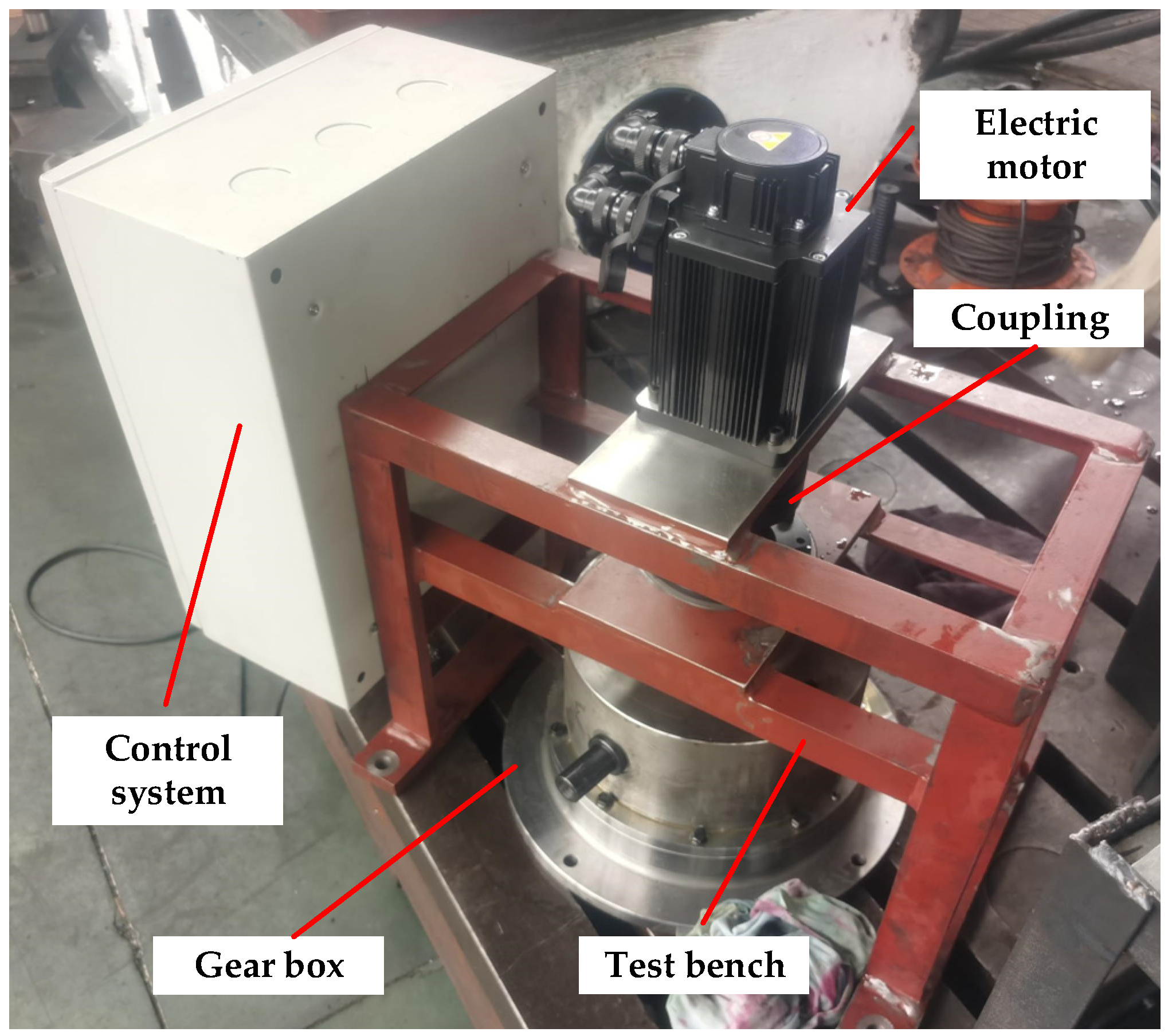
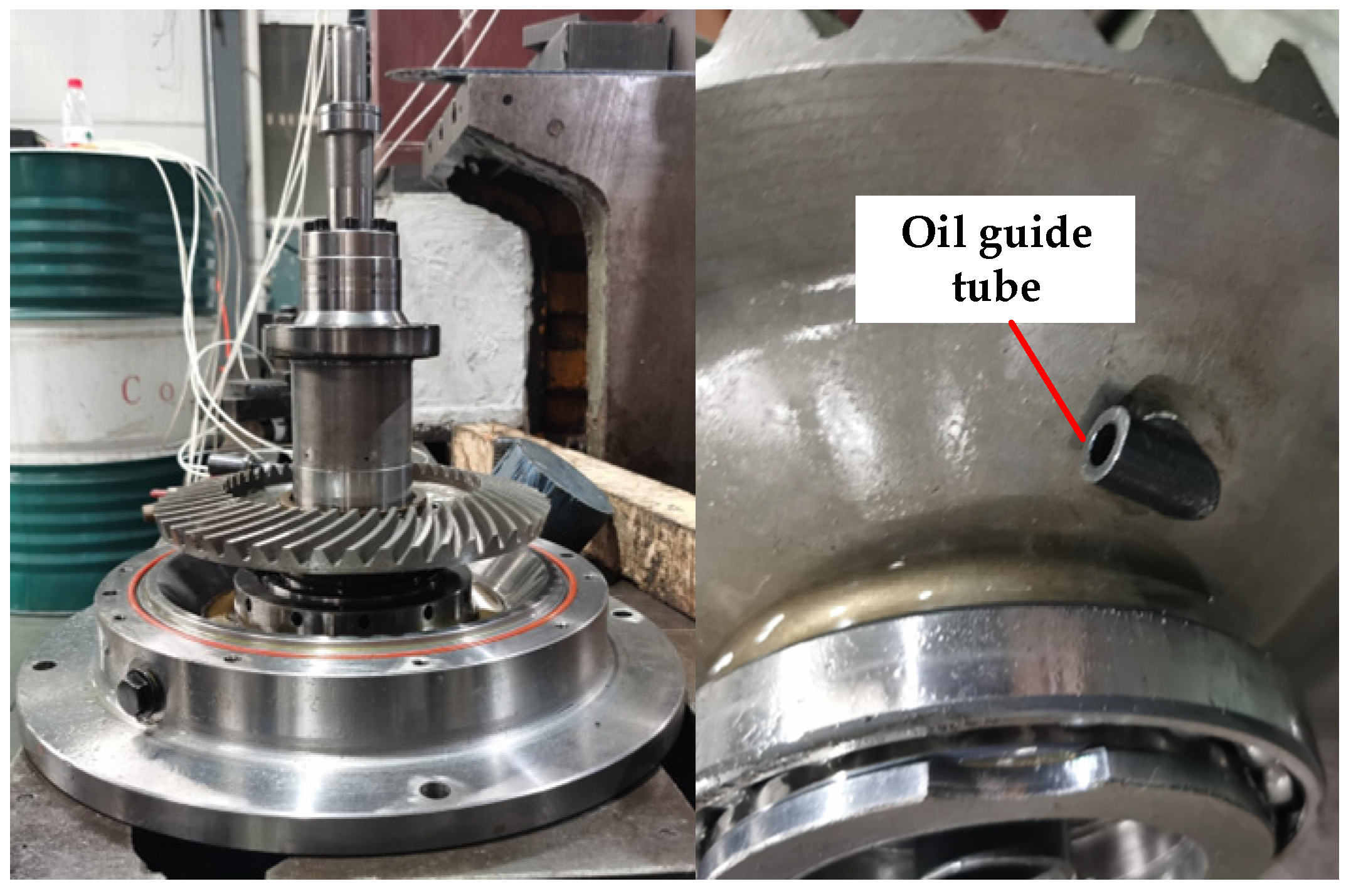

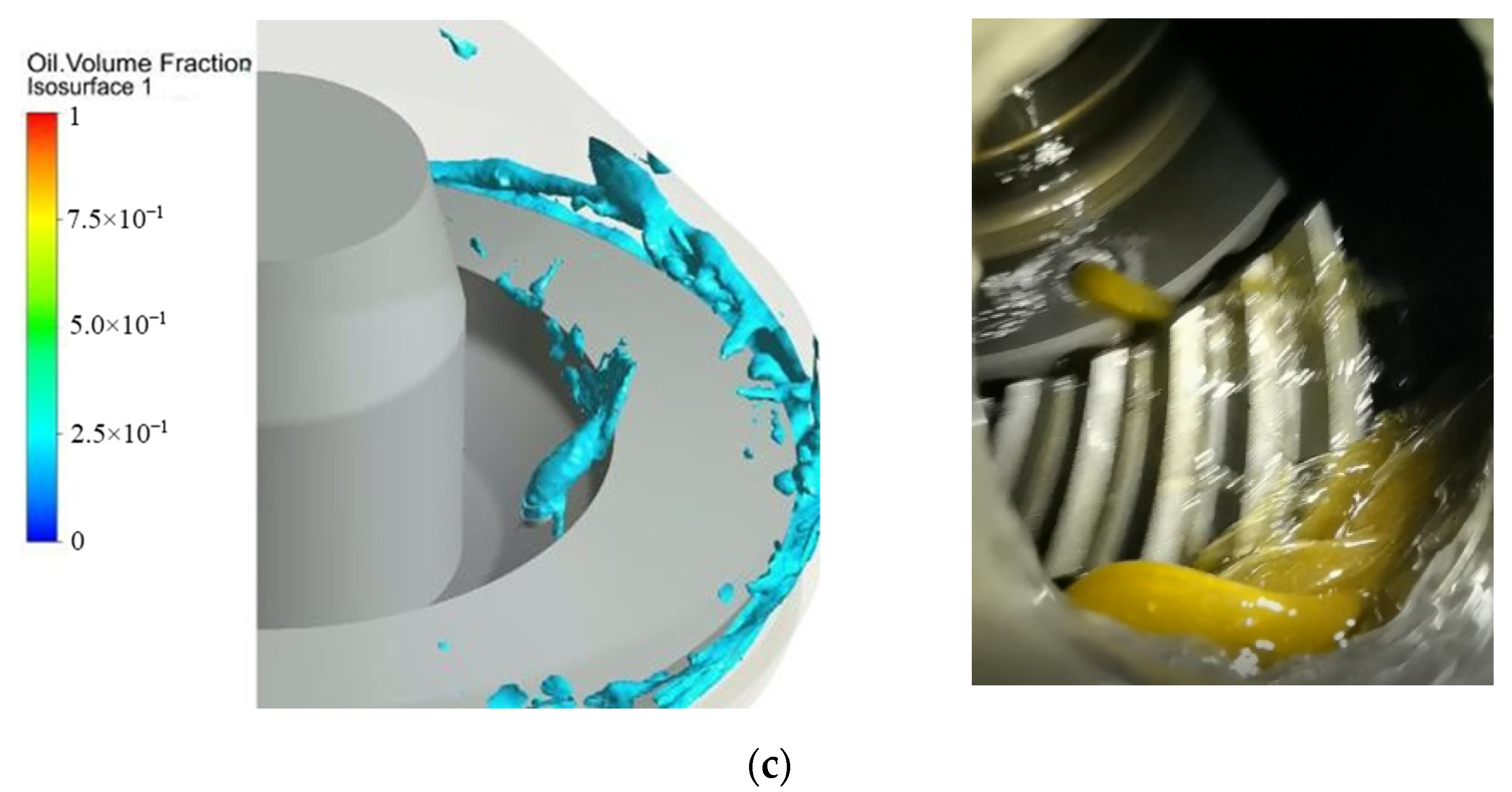
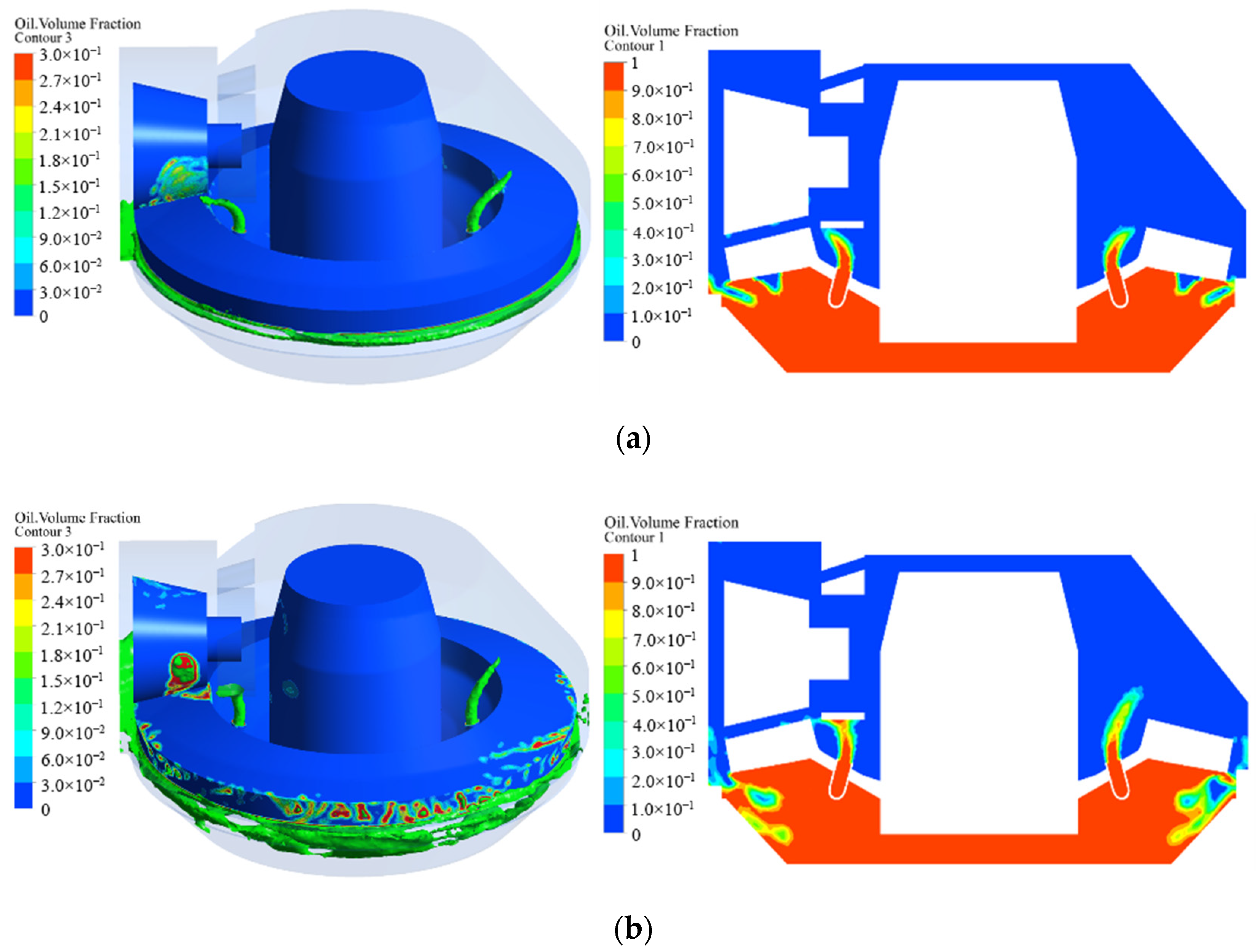
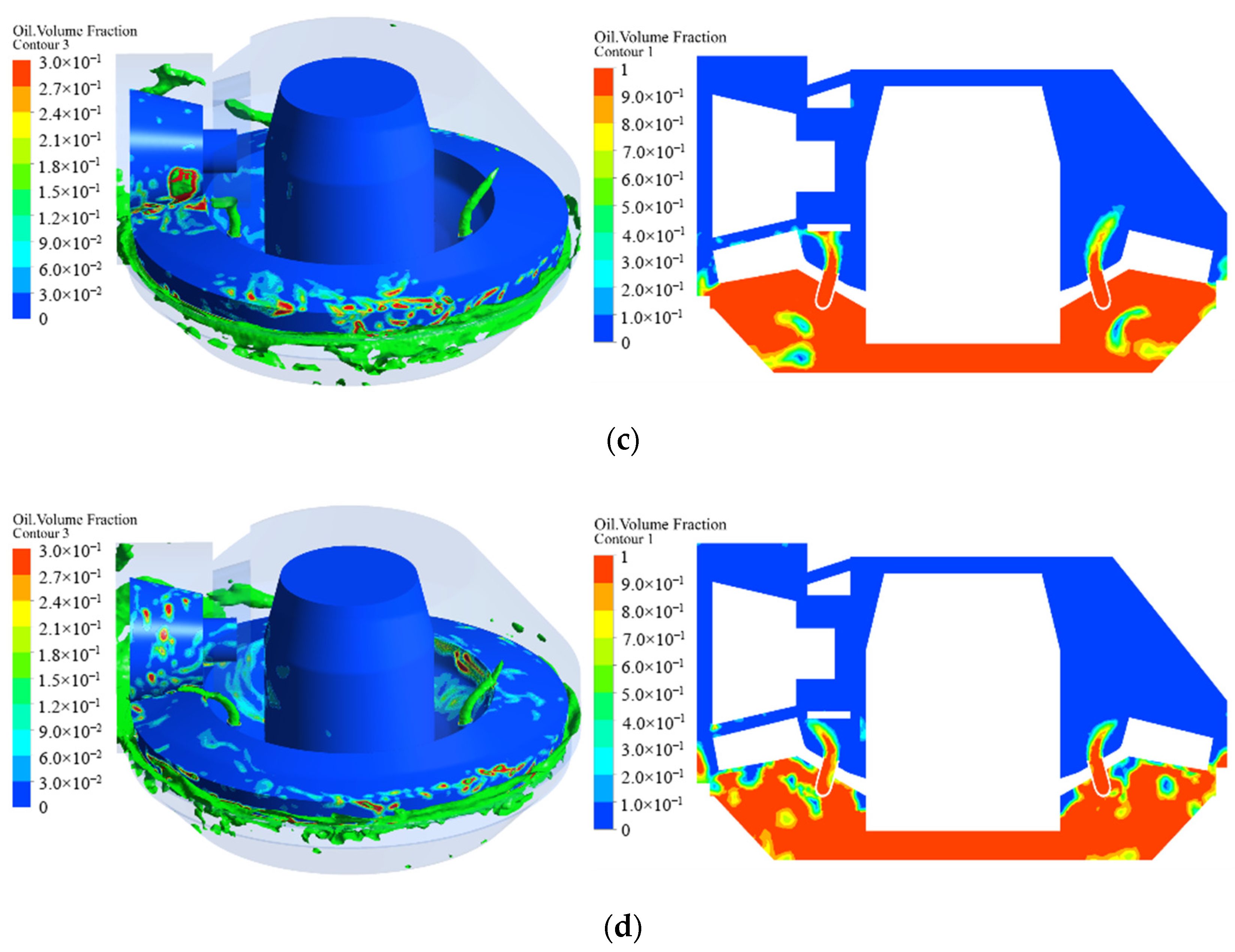

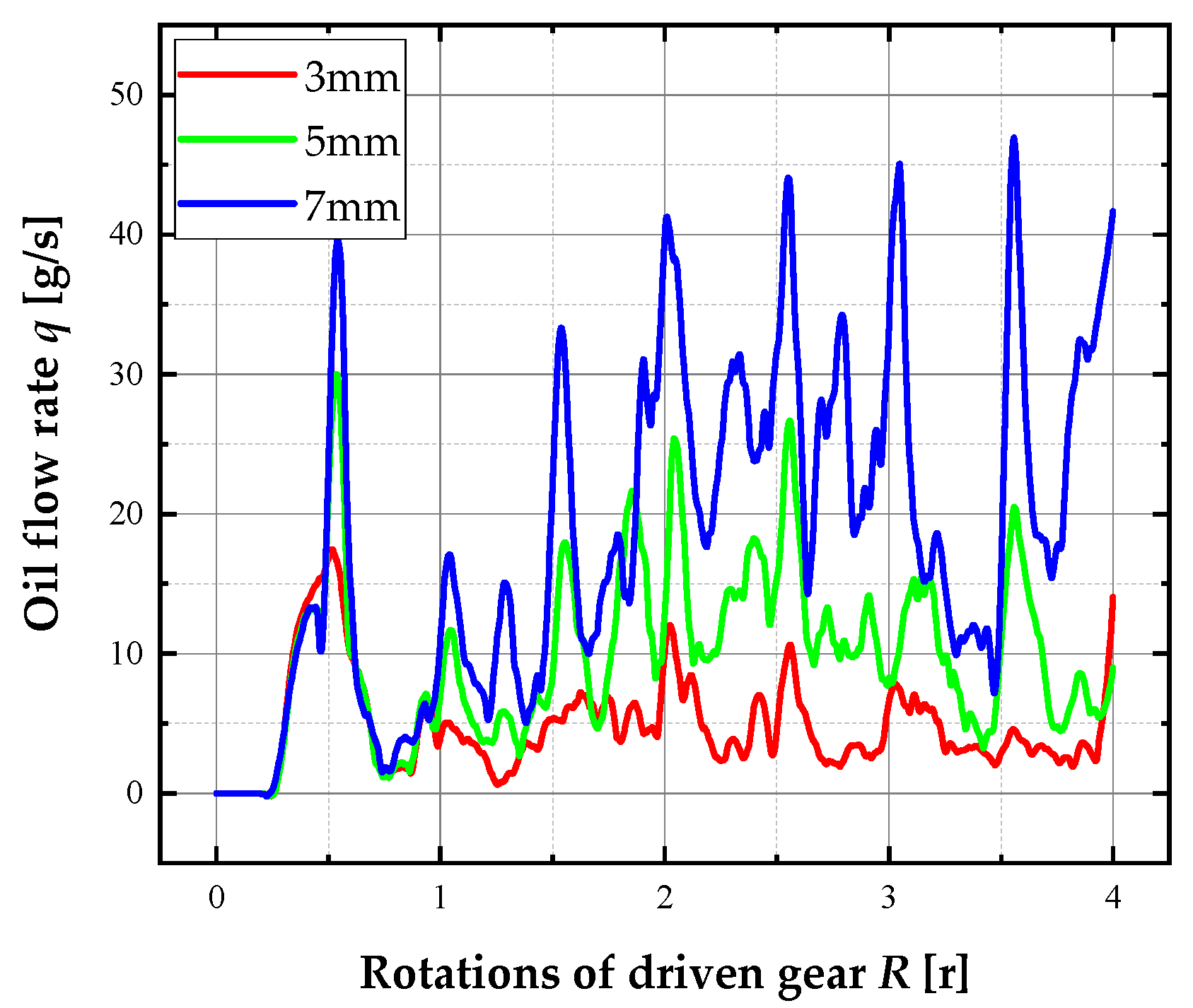

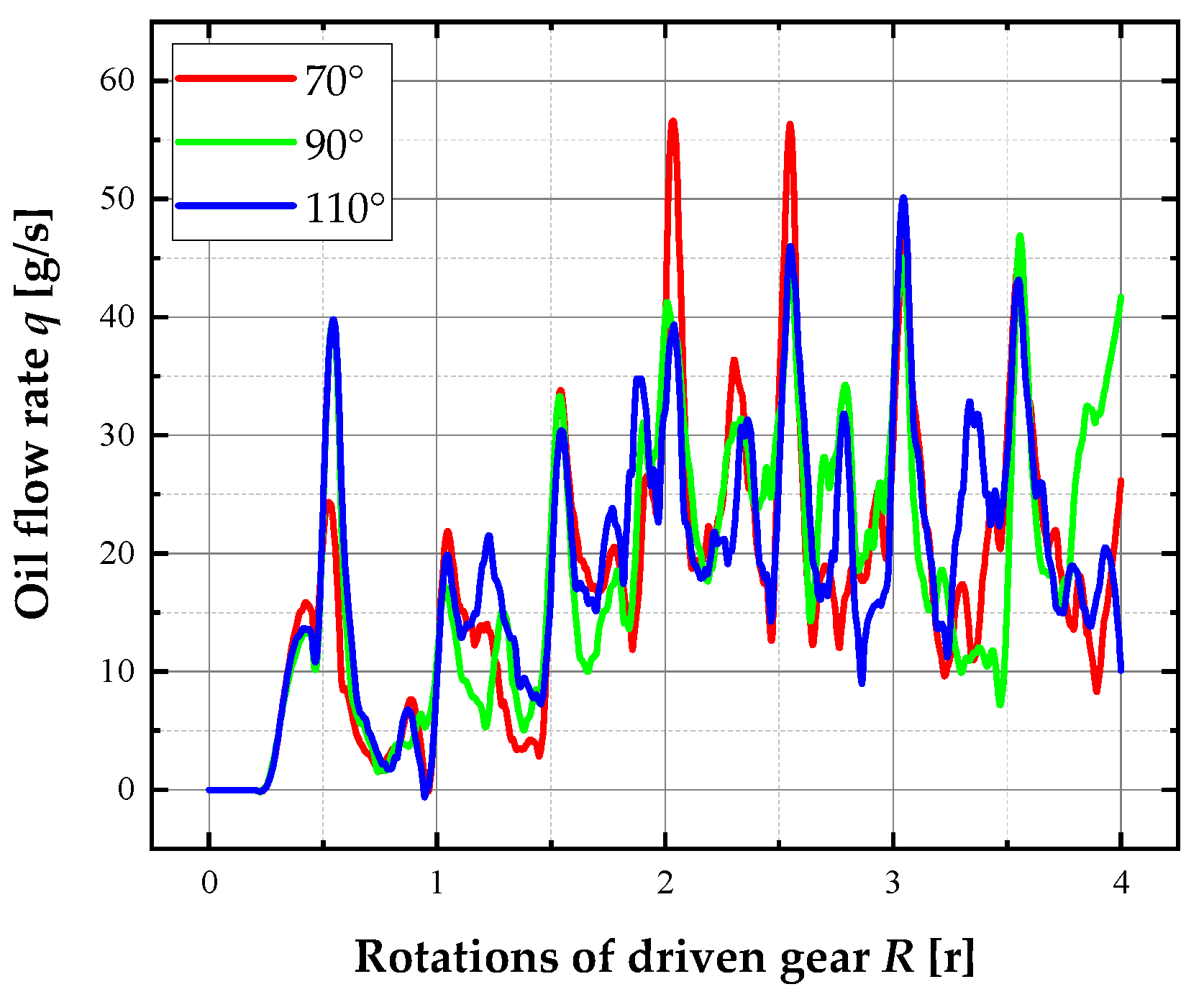
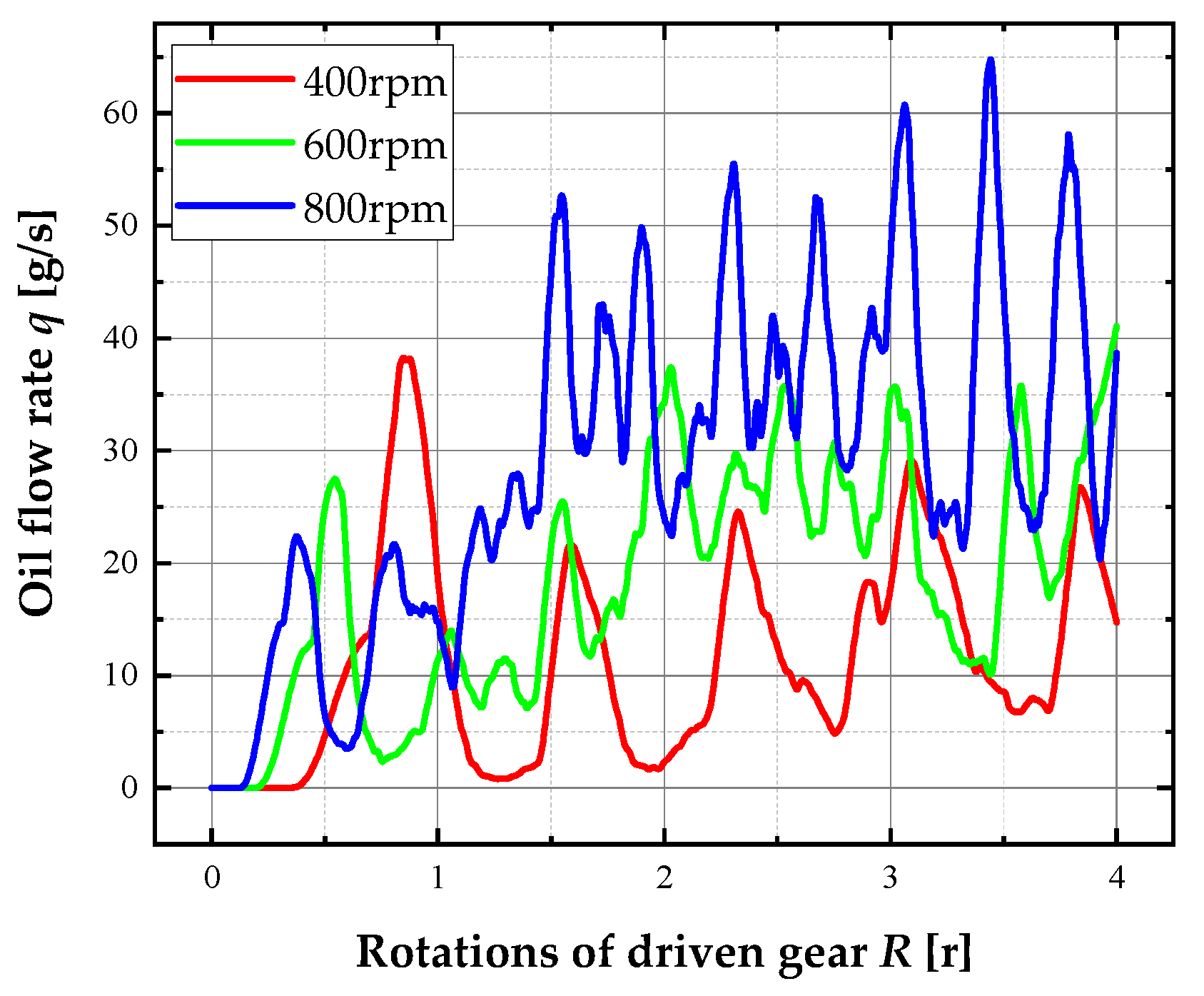
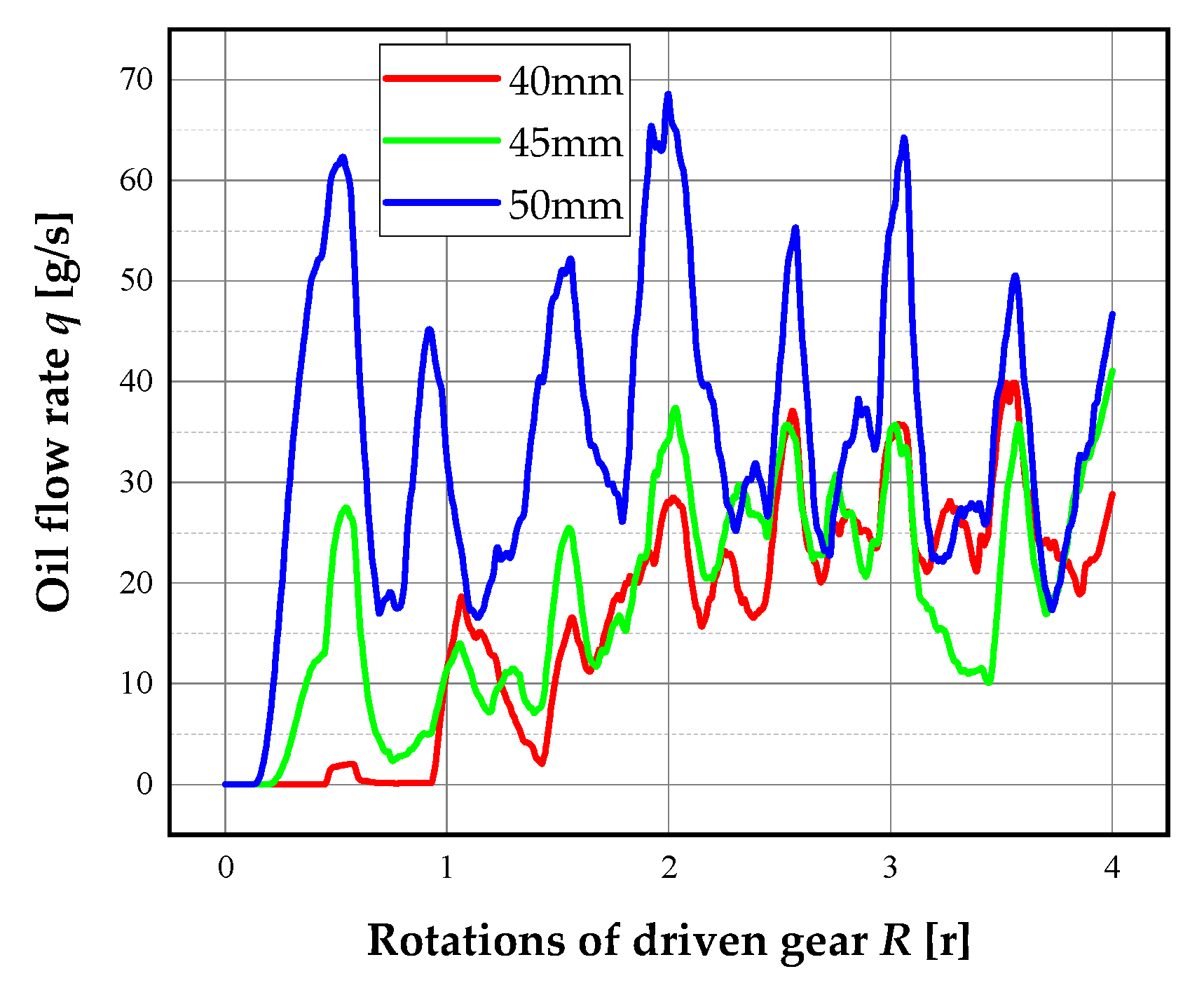
| Number of Grids | Mean Flow Rate of the Monitoring Surface (g/s) | |
|---|---|---|
| Case 1 | 1,172,836 | 23.3 |
| Case 2 | 2,350,738 | 19.3 |
| Case 3 | 3,885,689 | 18.4 |
| Case 4 | 5,976,802 | 18.1 |
| Inner Diameter d (mL) | Length of Installation End L (mL) | Angle of Oil-Guiding Tube θ (°) | Rotation Speed V (r/min) | Oil-Immersion Depth l (mL) | |
|---|---|---|---|---|---|
| Reference case | 7 | 12 | 90 | 600 | 45 |
| Inner diameter 1 | 3 | 12 | 90 | 600 | 45 |
| Inner diameter 2 | 5 | 12 | 90 | 600 | 45 |
| Length of installation end 1 | 7 | 15 | 90 | 600 | 45 |
| Length of installation end 2 | 7 | 18 | 90 | 600 | 45 |
| Angle of oil-guiding tube 1 | 7 | 12 | 70 | 600 | 45 |
| Angle of oil-guiding tube 2 | 7 | 12 | 110 | 600 | 45 |
| Rotation speed 1 | 7 | 12 | 90 | 400 | 45 |
| Rotation speed 2 | 7 | 12 | 90 | 800 | 45 |
| Oil-immersion depth 1 | 7 | 12 | 90 | 600 | 40 |
| Oil-immersion depth 2 | 7 | 12 | 90 | 600 | 50 |
Publisher’s Note: MDPI stays neutral with regard to jurisdictional claims in published maps and institutional affiliations. |
© 2022 by the authors. Licensee MDPI, Basel, Switzerland. This article is an open access article distributed under the terms and conditions of the Creative Commons Attribution (CC BY) license (https://creativecommons.org/licenses/by/4.0/).
Share and Cite
Liu, H.; Dai, Y.; Jia, J.; Zhu, X. CFD Investigation into Flow Characteristics of a Special Splash Lubrication in Light Helicopters. Aerospace 2022, 9, 482. https://doi.org/10.3390/aerospace9090482
Liu H, Dai Y, Jia J, Zhu X. CFD Investigation into Flow Characteristics of a Special Splash Lubrication in Light Helicopters. Aerospace. 2022; 9(9):482. https://doi.org/10.3390/aerospace9090482
Chicago/Turabian StyleLiu, He, Yu Dai, Jifu Jia, and Xiang Zhu. 2022. "CFD Investigation into Flow Characteristics of a Special Splash Lubrication in Light Helicopters" Aerospace 9, no. 9: 482. https://doi.org/10.3390/aerospace9090482





